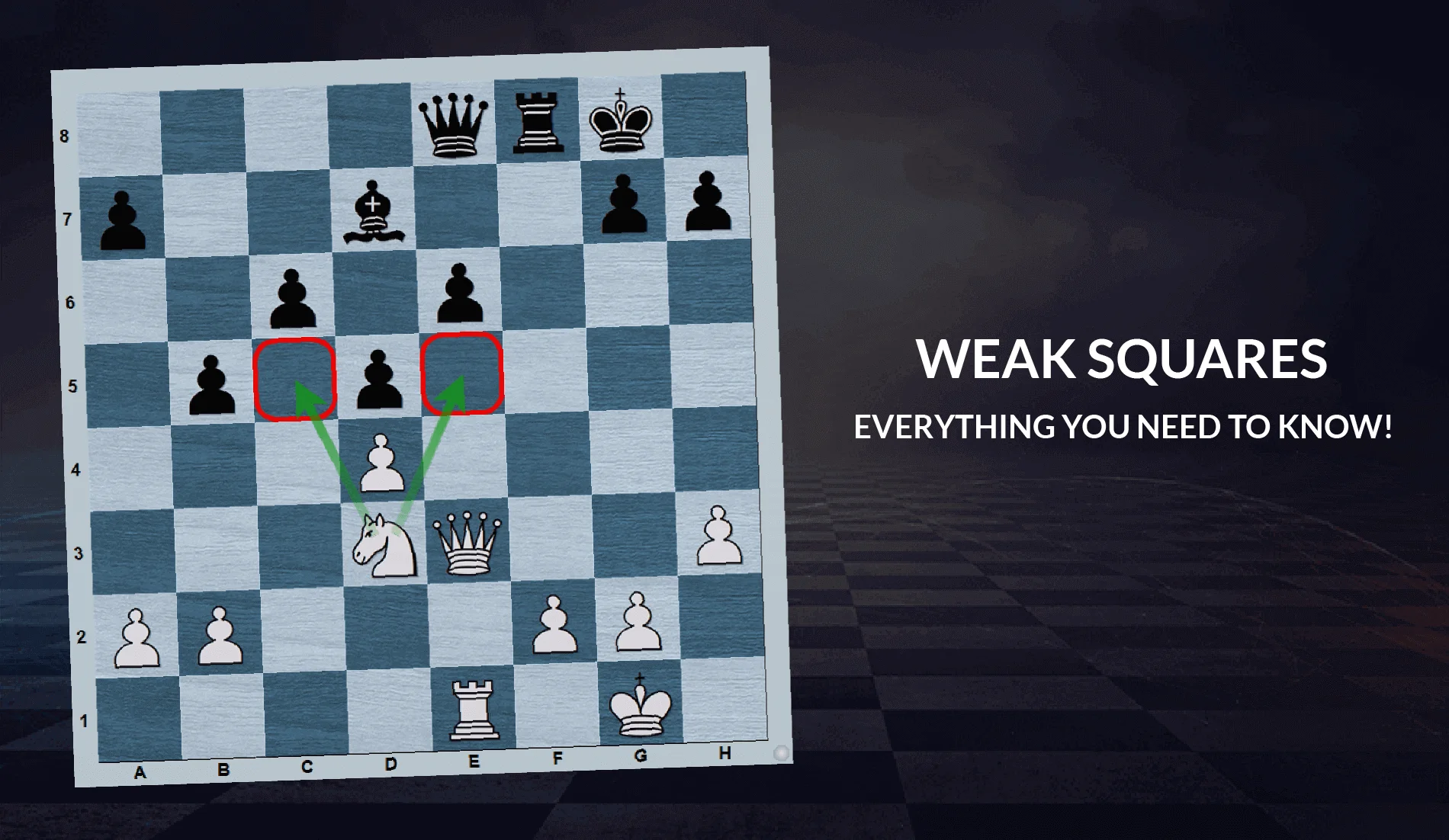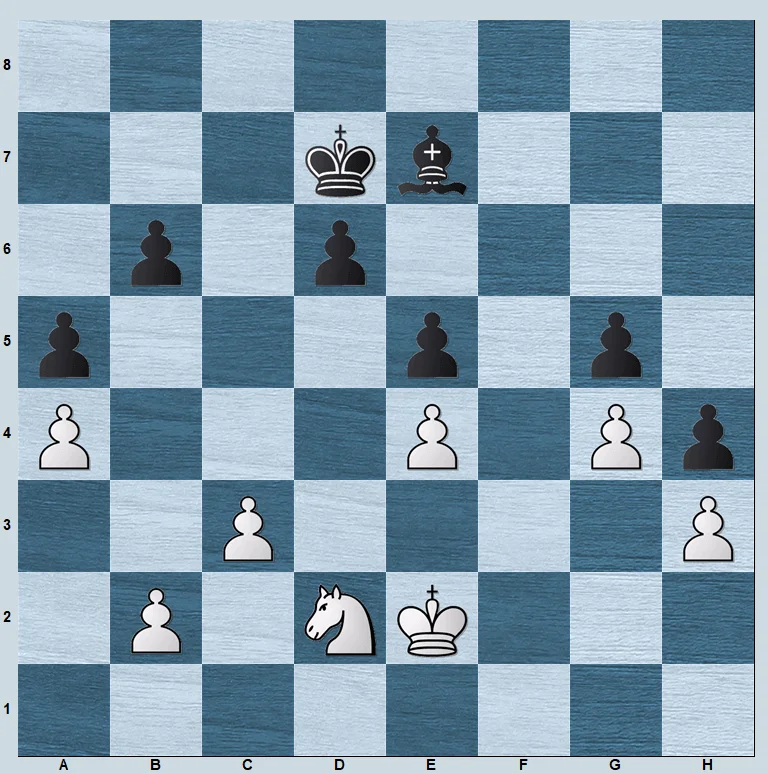Weak Squares in Chess: Everything you need to know!
Getting better at exploiting weak squares improves your ability to win equal-looking positions. This guide covers all you should know about weak squares!
Getting better at exploiting weak squares improves your ability to win equal-looking positions. This guide covers all you should know about weak squares!

One of the things players between 800-2400 levels overlook is weak squares in chess.
Let me share a famous position below, played between Fischer – Gadia.

The material is equal. Black seems to be doing fine with his Rooks on the open file, safe King, and a well-protected d6-pawn. But that’s not the case!
In fact, Black is practically lost. But why and how?
Because the biggest drawback of Black’s position is the weakness on d5. And after Fischer played 1.Nd5, they came under huge pressure, and in the next 5 moves, they resigned.
Such is the importance of weak squares. As you get better at recognizing and exploiting them, you’ll improve your ability to convert positions that look equal to an amateur but hopelessly lost to a master.
Not only will you become a more dangerous opponent, but also receive compliments for ‘magically’ winning positions. Friends and spectators have often complimented me on how effortlessly I won games by exploiting weak squares.
In this detailed blog post, I’ve covered everything you need to know about this topic. You’ll learn:
Let’s go!
A weak square in chess is a square that can’t be controlled by the pawns.
It sounds simple and is simple :-)
Whenever pawns don’t control a square, it becomes a weak one, as you can see below.


There can be many examples with one common point. In all of them, they can’t be controlled by the pawn.
Now we know what they are, let’s understand why they are so important. We will discuss it below.
You can see weak squares in the openings, middlegames, and endgames as well. To show how important and decisive they can be, I offer to start with an endgame position.
Let me show you a simple example of when the side controlling these squares wins the game.

In the endgame, Black has several weak squares marked with green.
The White King gets access to several weaknesses through them, and White wins.
Conversely, White has no weaknesses on the queenside, and no counterplay is possible.
Now let me make a few changes in the same position.

What are the differences?
First, the Black pawn is on f6 instead of f5. It now controls important squares g5 and e5, stopping the White King from entering the position.
On the other hand, the White pawn structure on the queenside is very weak, with several weak squares. It allows the Black King to enter the position.
Since we know the definition, recognizing them will be an easy but important step. We are looking for the squares that the opponent isn’t controlling or can’t control with the pawns.
Take a look at the position below and tell how many weak squares Black has.

As you can see, c5 and e5 are super weak. The Black pawns can’t control them.

White has no weak squares, which is why they have a positional advantage. Also, both of the squares' White controls are important central outposts. Using them, White will attack Black’s pawns.
Now let’s learn how to exploit them to get an advantage.
There will be many situations where the opponent will have a weak square, and you need to use it. In this part, we will see some examples and general ideas.
I suggest you focus on learning the logic and ideas, not the concrete moves.
The reason is it’s easier to learn one idea, which works in a thousand positions than the concrete moves in concrete situations happening once in a very long while.
Now try to identify the weak squares in the position below and how you can make the most out of them. It’s White to play.

Think before you read further.
So White has an amazing structure, and many pawns are fixing the good squares for the Knight on d5, b5, and f5! The King can also very quickly advance to c4.

By using any of these squares, White gets good activity. Slowly White will be able to push back the opponent’s King.
And by using light squares, the White King will invade Black’s camp.
In the next part, we’ll see how heavy pieces can also use weakened squares.
In the diagram below, it’s White to move. Try to identify the weak squares and how White can use them.

Both players are fighting for the open c-file. The pawns on the dark squares limit the Black Bishop. They are also perfect targets for the White’s Bishop. This gives White an advantage.
But, it’s not enough. White needs to put more pressure on the opponent’s position.
So White uses the weakest square in the opponent’s camp – c6 and plays:
1.Rc6!

Now both pawns are hanging. If Black captures, White gains super-strong protected passed pawn on the 6th rank. By the way, in our article on open files, you’ll find more ideas and tricks on how to use heavy pieces.
When considering exploiting weak squares, we must ensure we have the right piece to do so.
Sometimes, we have several pieces to put on the vulnerable squares.
Often several options are good, but let's try to understand why it is important to use the right ones.
In the position below, it’s White to play and they have a big advantage.

Black’s structure is destroyed on the Kingside, and there are several weak squares. The f5-square is the most attractive one as it’s also closer to the center.
How to play here?
Should you occupy the f5-square with the Bishop or the Queen? To help you visualize, let’s see each of them on f5.


Both look interesting. However, the Nf8 protects the h7 spot, so there's no real danger for the Black King.
I would like to show you the third option. Imagine White’s Knight goes via e2-g3 to f5!

As you can see, the Nf5 attacks the pieces and controls other weakened squares like g7 and h6. With the Queen, White will create many dangerous threats against the opponent’s King.
Weak squares can be very important in an attack. In the next section, we will go deeper into that part.
I am sure after seeing the word 'attack' many of you said finally!
And I understand your feelings. Attacking in chess is one of the most enjoyable parts of the game.
We love to attack, destroy, and crush the opponent’s King and here we will see how weak squares can be helpful.
Once again, look at the position below, identify the weaknesses next to the opponent’s King and find the best move. It’s White to play.

Since the pawn is on g6, we can identify that dark squares on f6 and h6 are vulnerable.
Can we use them?
Absolutely! With 1.Ng4, White creates decisive threats.

If you notice, the Black King doesn’t have good defenders nearby.
Weak squares are also important while defending, and in the next section, we will also cover it.
In the position below, Black sacrificed a pawn to gain the Bishop pair. They also have an open f-file to create an attack. The last move was Qh4.

Now the pawn on f2 is hanging as well. Black sometimes wants to open up the Bd6, playing e4 and attacking h2. Pawn moves like g3 will weaken light squares a lot, so how to defend?
1.Nde4!

White defends against all of the threats mentioned above. They also close both of the opponent’s Bishops. Black’s attack is over and the White King feels very safe now.
As you can see, defending weak squares can be the reason why the opponent’s attack doesn’t work. So what can you do in such situations?
You might be familiar with the position below. With little differences, it’s the same position that we have covered. The Black Bishop on g7 is a great defender of the dark squares.

But White also has a dark-squared Bishop. And they can use it to trade the opponent’s Bishop and create a weak square complex near the Black King.
1.Bh6!

Now we will get the same attack that we have seen previously. So while attacking, we can try to trade defenders and weaken the squares.
Let me mention that exchanging the defender doesn’t apply only to attack. Have a look at the example below.
Overall, it’s good to remember that exchanging the defender of the weak square can often be important, allowing us to take maximum value out of the weakness.
Now that you know how to utilize weak squares let’s understand how to create one.
Some of the most common options you have are:
One by one, let’s have a look at them.
In the position below, it’s White to move. We have a great option to destroy the opponent’s structure on the Kingside!
This is another way to create weaknesses.
In the position below, it’s White to move. Are there any weak squares, or do we need to create them?
Even though Black didn’t have weak squares, their position was destroyed after White weakened their structure.
This is another way to entice your opponent into creating weak squares.
In the position below, White Bishops aim at the opponent’s King. However, Black’s structure is solid. So how to provoke a weakness?
By the way, pay attention that White tried to weaken dark squares, as Black is missing that Bishop. They’ll not potentially have a good defender.
Sometimes, we will advance our pawns to gain some space, fix opponent pawns and create weaknesses.
Sometimes, the importance of creating weak squares is so significant that sacrificing material could make a lot of sense. This is a well-known chess strategy at the higher level.
And a common way to exploit this is by sacrificing an exchange!
In the position below, it’s White to move. What will be your decision?
White destroys the opponent’s pawn structure and gets a winning position.
By now, we have seen different situations when we were trying to use the weak squares.
But what if we are the side that has to deal with them? That’s what we are going to discuss next.
In this case, here are some common options you have:
Let’s understand each of these options.
Sometimes, even though we have a weak square, we will have a chance to get rid of it. In the position below, Black’s d5 pawn controls our e4-square.
How can we get rid of it?
But what if you can’t get rid of a weak square? In that case, you have another option.
Exchanging the pawn or pieces in charge of controlling a weak square can be an excellent defensive technique.
In the next section, we will dive deeper and discuss the concept of useless weak squares.
A weak square is useless when we don’t have the right pieces to use it, or there is no value in controlling and using that square.
Let me show a few more examples to make it clear.
Have a look at the position below and identify the weakened squares in Black’s camp.

I am pretty sure you must have found out that the squares d5, e4 and f5 are very weak.
But how to use them?
White doesn’t have the right pieces 🙂

Having the right piece to exploit a weakness is very important.
Another case is when we have a good piece to occupy the weak square, but there's no need to do so.
Do you know there are 4 weak squares(2 per side) in the opening phase of the game?
Sometimes, you can use it to gain a big advantage.

From our Opening Principles course, you'll know that the squares f2 and f7 are weak since the Kings are not the best defenders and often big pressure creates dangerous threats.
At the same time, the squares on c2 and c7 are weak since after the Queen leaves its initial squares, they can be targeted.
I’ll offer you a little homework. What common weak squares from our opening courses come to your mind?
Let me know in our forum.
Now I invite you to go ahead and summarize our article.
As you’ve seen, understanding weak squares is important.
They can give you a winning edge in an equal position. And sometimes, strong players will give up material just to control a particular square.
From now on, I hope your opponents will regret creating weaknesses on the board :-)
Thanks for reading. Do share your thoughts on this topic in our chess forum!
Originally published Sep 12, 2022

